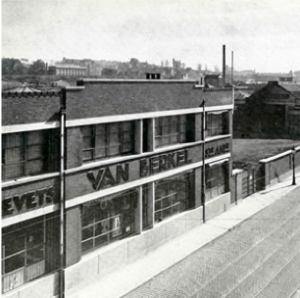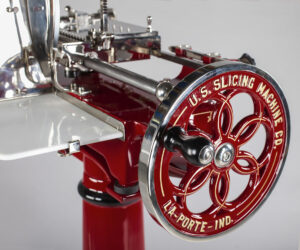Historical notes on the birth of the most famous meat slicing machines in the world, a symbol of craftsmanship, style and quality.
On February 5th, 1869, in Enschot (Netherlands), Willhelmus Adrianus Van Berkel was born. Growing up, the young and brilliant Van Berkel, decided to combine his passion for mechanics with his work as a butcher, developing a system for slicing meat that included a mechanical device that could facilitate the work of butchers, providing more uniform cuts in terms of slice size and thickness. In a few years he became an entrepreneur and started commercializing his great invention: the Van Berkel meat slicers.
What was Berkel’s greatest intuition, capable of revolutionizing the market?

Everything started from the complaints of his clients. In fact, it is said that Berkel’s customers were constantly complaining about the irregularity of cuts of beef. At that point, tired of controversy, Van Berkel had the intuition to create a machine able to mechanically reproduce the movement of the human hand when slicing. Van Berkel managed to build a brilliant device, which immediately proved to be extremely accurate and functional, trying it directly on his daily work, inside his butcher shop.
This new instrument, the Van Berkel meat slicing machine, combined a large circular and concave blade, with a large flywheel that was operated by hand and a mobile cart that automatically advanced towards the blade. That was the basic principle of the first Van Berkel meat slicer.
A short time later, Berkel realized the enormous potential and decided to patent the slicer that would revolutionize the meat cutting sector. However, he didn’t have the necessary means to start the production of his slicer, and decided to rely on the forging workshop in Ljsbergen, which was in bankruptcy. He made a proposal to the owner to transform his old workshop into a laboratory for manufacturing of his flywheel slicers.
Creation of the Van Berkel Slicing Machine company

On October 12th 1898 in Rotterdam the van Berkel trading company was founded and the first factory for the production of flywheel slicers started its activity. Since then, the company has registered great success, by presenting an unprecedented level of innovation to the market.
The first-year production saw the development and marketing of:
– 76 Van Berkel meat slicing machines Model A;
– 3 Van Berkel meat slicing machines of reduced dimensions, Model B;
– 5 special meat slicing machines, Model C.
The introduction of the Berkel meat slicer, however, caught the very first criticism precisely from the insiders, the butchers and the employees of various food shops, who saw the slicer as a threat to their work.
Van Berkel didn’t give up. He showed the butchers how his machine could help improve their everyday work, but not only that, he showed them how the slicer, its speed and accuracy could originate an increase in sales.
When the advantages were evident, Berkel slicing machines were soon recognized as valid instruments and spread all over the world. In time, several factories were born to manufacture and satisfy the demand for Berkel slicing machines, at an international level:
– Denmark (1905);
– Sweden, Belgium and Switzerland (1909);
– United States, South America, Norway, Germany and France (1911);
– England (1913);
– Austria, Czechoslovakia and Italy (1924);
– Canada (1929);
– Spain and Portugal (1939).
– The Van Berkel meat slicing machine quickly became a real multinational company with production plants all over the world.
In the United States of America, in the 1930s, Van Berkel received an award as the best slicing machines manufacturer in the world.
The Van Berkel slicing machine: iconic tool and status symbol

It’s really an unexpected thing to be able to turn a slicer into a style icon. But that’s what happened with Berkel meat slicing machines.
Even after the death of its creator (in 1952), the Berkel flywheel slicing machine remained a true icon of style for its design, shapes, harmony of movement, the shine of the blade and the typical red color, which soon became a distinctive mark, capable of evoking memories, charm and elegance.
What is a Van Berkel slicer today?

While Berkel slicing machines continue to enjoy an excellent reputation on the market, the oldest and restored machines have become cult objects, sought after and listed by collectors, and antique dealers, as well as highly appreciated by interior designers and used in the most exclusive delicatessen shops, high-end hotels and restaurants, and in the homes of quality and tradition food lovers.
How to find an authentic restored Berkel slicer?
Since 2004, the Van Berkel brand is managed by an Italian entrepreneurial group, which activity is focused on manufacturing modern electric slicing machines, which have different characteristics such as speed of cut.
The old models of Berkel meat slicer machines, with their charm, fascination, design and history, can nowadays be found only in a few restoration shops, just like ours, where in spite of the signs left by time and rust, the slicing machines’ original soul still lies underneath the old aspect, waiting to be restored by the skilled hand of Italian craftsmen.

